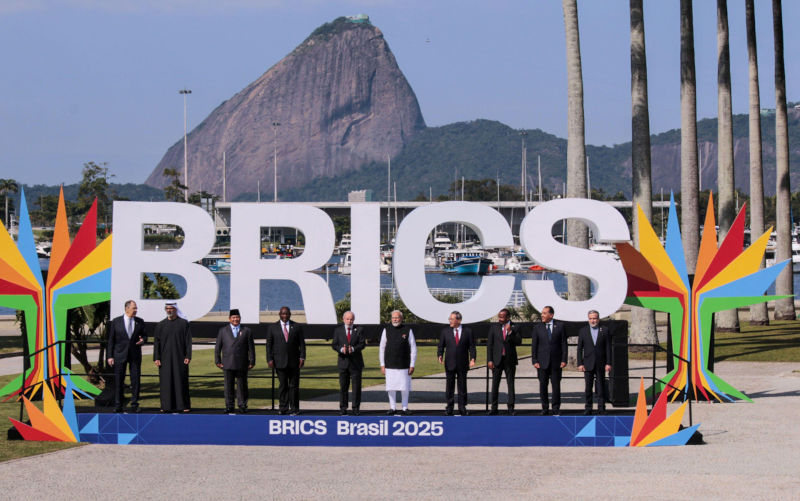Trump’s attacks are driving what BRICS was meant to do: encourage co-operation among non-Western powers and reduce dependence on the US
August 18, 2025
At first glance, US President Donald Trump’s renewed “America first” agenda seems aimed at the heart of the BRICS bloc of developing nations.
With threats of punitive tariffs and direct provocations, Trump has positioned BRICS as a target in his second term. Yet rather than splitting the bloc apart, his aggressive policies are fortifying it.
Since returning to power, Trump has vowed to punish countries trying to create an alternative to the US dollar, including a threat of 100% tariffs on those attempting to challenge the US currency. As last month’s BRICS summit in Rio de Janeiro came to a close, he threatened to charge any country supporting the bloc’s “anti-American policies” an additional 10% tariff.
His threats are not having the intended effect. Instead, it is the US’ own relations with the BRICS members that have come under strain. The clearest example is India, a critical “swing state” within BRICS. Despite India’s strategic importance to Washington as a counterweight to China, Trump has repeatedly undermined trust between the two nations.
He invited Pakistan’s army chief Field Marshal General Asim Munir to a private lunch at the White House in June. More recently, after slapping a 25% tariff on Indian exports, Trump announced an additional 25% tariff over its purchases of discounted Russian oil, a move India’s Ministry of External Affairs condemned as “unjustified and unreasonable”.
Trump’s relationship with Russia is little better. While he has positioned himself as a would-be peacemaker between Russia and Ukraine — raising the prospect of luring Russia away from China in a reversal of Richard Nixon — in reality he has only heightened the risks of a nuclear war.
In response to remarks by former Russian president Dmitry Medvedev about Russia’s nuclear strike capabilities, Trump said on social media that he had ordered US nuclear submarines to be positioned in “the appropriate regions”. The Russian foreign ministry followed up by declaring that Moscow was no longer bound by a moratorium on the deployment of short- and medium-range nuclear missiles.
While a summit between Trump and Russian President Vladimir Putin is scheduled, structural differences over Ukraine and European security are unlikely to be resolved in a single meeting.
South Africa and Brazil have also been targeted by Trump. South Africa faces 30% tariffs that officials warned would hit its economy hard. Trump has cut off aid to the country, accusing it of discriminating against its white minority. He has also said he would not attend the Group of 20 (G20) summit in Johannesburg in November over his disapproval of South African policies, including land reform and its legal proceedings against Israel for its conduct in its war in Gaza.
Meanwhile, Trump has targeted Brazil with a 50% tariff, reportedly over Brazilian President Luiz Inácio Lula da Silva’s treatment of his predecessor Jair Bolsonaro, who is accused of leading an attempted coup to overturn his 2022 election defeat. Rather than a calculated divide and conquer strategy, these measures signal blanket antagonism towards all BRICS members regardless of their internal differences or diplomatic potential.
Of course, China remains Trump’s primary target, but he continues to push for a direct summit with President Xi Jinping while a high-level US business delegation tries to revive discussions and secure a Xi visit to the US. Recent US-China trade talks in Stockholm resulted in another 90-day pause on escalating tariffs. However, Trump’s unilateralism is backfiring here, too, as his efforts to isolate China have instead reinforced Beijing’s image as a rallying point for nations resisting US-led economic coercion.
The newest BRICS members have not been spared, either. Indonesia has faced regular tariff threats since officially joining the bloc in January. Even Vietnam, a newly minted BRICS partner and key node in Chinese supply chains, faces a 20% US tariff plus 40% levies on goods suspected of being diverted from China.
Trump’s actions might be doing more to bring the BRICS nations together than any summit communique ever could. The bloc is acting not just as a symbolic alternative to Western institutions but a practical one. Its initiatives are not anti-American by design but are increasingly necessary responses to Trump’s hostility.
The coming G20 summit in Johannesburg will be an arena for all these dynamics to play out. Will US officials participate, and if so, will they continue to attack BRICS directly or attempt to court its members? The answer will signal whether the Trump administration still sees value in engagement or if its zero-sum mindset will continue alienating allies and adversaries alike.
For all his bombast, Trump’s second-term foreign policy appears more reactive than strategic. His confrontational style lacks a clear framework for winning over the Global South. If his goal is to isolate China, he cannot afford to alienate countries such as India, Brazil or South Africa. Yet, by punishing them in the name of upholding US supremacy, he is reinforcing the very multipolar world he claims to oppose.
Trump’s blunt diplomacy is catalysing exactly what BRICS was designed to do: encourage co-operation among non-Western powers, reduce dependence on the US dollar and offer an alternative to US-led institutions. Every sanction, insult or tariff threat strengthens the case for a more balanced global order.
Republished from South China Morning Post, 14 August 2025
The views expressed in this article may or may not reflect those of Pearls and Irritations.
